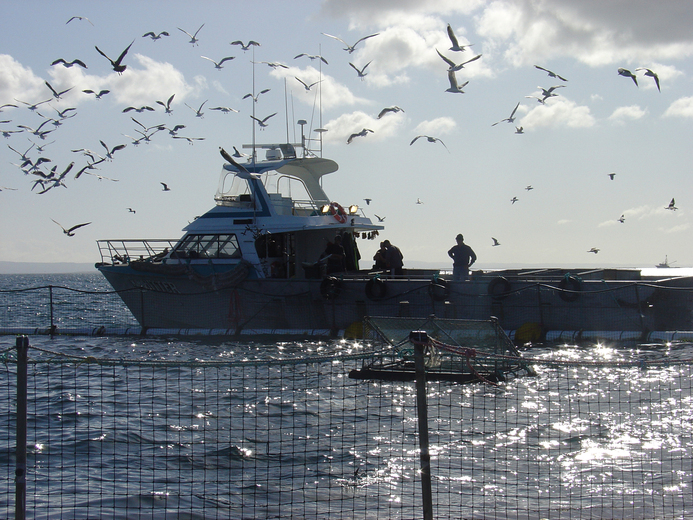5 What can we expect?
Many areas of South Australia’s coastal and marine environments are declining, with increased pressure resulting from development and resource use. There is a high level of awareness of the needs of our coasts, and a number of plans and programs hope to address existing and future challenges.
5.1 Climate change: understanding resilience and connectivity
Climate change is likely to profoundly affect the coastal and marine environment, although the severity and extent of potential and existing changes in the marine environment due to climate change are not certain and still have to be quantified. Ocean salinity and currents are changing; ocean acidity, sea level and storm frequency are rising; all of these changes will impact marine species. There are concerns, for example, that some coastal vegetation, such as mangroves and saltmarshes, might not have space to retreat when sea levels rise. Research by Falkenberg et al. (2012) from the University of Adelaide on the resistance of kelp forests to impacts of pollutants indicates that, although forecast climates might increase the probability of phase shifts, maintenance of intact populations of foundation species could enable the continued strength of interactions and persistence of communities. Our understanding of resilience and connectivity in South Australian marine systems is too limited for any inference on how marine ecosystems cope with and adapt to multiple pressures, including climate change. Greater knowledge in this field is needed.
The high number of fish deaths along the South Australian coast in early 2013 has been ascribed to unusually high water temperatures and possible harmful algae. Satellite imagery for March 2013 confirmed the presence of algal blooms. Conditions favourable for oceanic upwellings, coupled with increased temperature, support algal blooms.
5.2 Growth in the resources sector and shipping
The number of mines is forecast to increase during the next few years (SACOME 2012). There is considerable pressure on the Spencer Gulf marine environment from the expansion in mining and the cumulative impacts from various related facilities, such as port facilities and desalination plants.
The expected growth of the oil and gas industry, particularly in the western part of the state, is likely to increase pressure on marine habitats and migratory species, such as the southern right whale.
Globally, there is a trend towards larger ships that will require deeper channels and larger berths. This will probably require new or expanded ports, with related impacts on coastal and marine environments.
5.3 Further coastal and offshore development
Monitoring of ecological conditions in nearshore marine waters throughout South Australia demonstrates that, wherever there is development near waters or in the water (e.g. sea-based aquaculture), there is an observable degradation of the adjacent marine ecosystems. In the absence of exceptional planning controls and pollution management, the trend of development on and off the coast will lead to further degradation of the nearshore environment. For example, expansion of aquaculture zones into ecosystems in good condition presents a risk of ecological harm.
Wave and tide farms for energy production have been proposed during the past two years. Although such initiatives could potentially make a contribution to reducing carbon emissions, potential impacts on marine mammals have to be carefully evaluated.
5.4 Improved monitoring, evaluation and reporting
Knowledge of coastal, estuarine and marine ecosystems has improved greatly during the past five years. However, much more has to be done to assess and properly report on the condition of these ecosystems across the state. For many regions, it is not possible to fully evaluate the effectiveness of management actions because of inadequate monitoring. Furthermore, baseline information on the condition of ecological communities is greatly needed for many areas. Assessment of the effectiveness of key government strategies and plans, such as marine parks (Government of South Australia 2012), No Species Loss nature conservation strategy (Government of South Australia 2007), and the State Natural Resources Management Plan (Government of South Australia 2011b), is restricted by a lack of comprehensive and ongoing monitoring, evaluation and reporting under these strategies and plans. The monitoring, evaluation and reporting program envisaged for the state’s marine parks network and the reporting framework anticipated in the state NRM plan aim to evaluate the effectiveness of current and future projects and programs. This will allow us to further improve efforts to protect and restore our coastal and marine environments.

Tuna aquaculture, feeding sardines to tuna with scavenging seagulls, offshore from Port Lincoln
Dr Jane McKenzie
5.5 Valuing ecosystem services and adopting an ecosystem-based approach to management
In spite of the obvious and significant social and economic benefits described in this chapter, there has been no comprehensive attempt to value the products and services provided by coastal, estuarine and marine ecosystems. Better understanding and quantification of these products and services would improve our ability to manage them sustainably, and to fully consider the costs and benefits of developments and uses that affect them. An ecosystem-based approach that integrates management across sectors and identifies thresholds for ecosystems, taking into account the ecosystem services they provide, is greatly needed (Millennium Ecosystem Assessment 2005). This should build on the work under way to value ecosystem services as part of monitoring, evaluation and reporting of marine parks and the Adelaide Coastal Waters Improvement Plan.